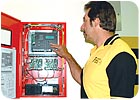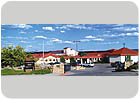Customization: Big Deal for Little Sisters

Regardless of the type of facility, when a fire alarm is activated, it’s serious business. Everyone must remain calm. Established procedures must be followed. Response by the appropriate personnel must occur quickly. And of course, it must be determined whether or not there is an actual fire emergency.
Now, with all of these concerns, imagine if the vast majority of the people in the facility are unable to leave the property on their own. The gravity of the situation could be increased exponentially.
This is the challenge faced by the Little Sisters of the Poor in Gallup, N.M. Originally created as a private, non-profit, Catholic nursing home, the three-acre facility now features a modern, assisted living component added several years ago. The new three-story complex is connected to the main facility and enables residents who don’t need a comprehensive nursing home atmosphere to live independently while giving them access to the services they might need from time to time.

Evacuation assistance
Still, at least 95 percent of the residents in the two buildings would require some level of assistance evacuating the premises should a fire alarm go off. While some might need minimal help, others would require wheelchairs and other assistive devices. While nurses and other personnel in the facility are trained to handle such tasks, both residents and workers would like to avoid it unless absolutely necessary. So to keep disruption to a minimum, the workers would need to be able to quickly determine if there is actually a fire and, if there is, be able to determine its exact location so only the people in proximity to the fire would have to be evacuated.Until recently, neither of these capabilities was possible with the existing fire protection system: a conventional, 10-zone panel with about 300 points of protection incorporating pull stations, smoke detectors and duct detectors. If a fire alarm was activated, the panel might show something like, “Zone 1 North Wing.” The problem was a zone might contain 20 to 30 protection points, and facility personnel had to try to isolate exactly where the problem occurred.
In addition, because the emergency could not be readily identified, the fire department had to err on the side of caution and dispatch engines to the scene.
The solution was clear: an addressable system that would not only pinpoint the exact location of a potential fire situation, but one that would allow personnel to determine its true nature. Joe Mesich, owner of Advanced Technical Services, also in Gallup, helped with a fire protection system from Silent Knight, Maple Grove, Minn.
At its heart is an IFP-1000 intelligent analog/addressable fire control panel. The basic system had a single signaling line circuit (SLC) loop, which can support 127 SLC devices, expandable to 1016 points (eight total SLC loops with a maximum of 127 devices per loop) using simple expansion cards. It featured six on-board Flexput circuits that can be configured for notification outputs or for conventional smoke detector inputs. Ultimately, it was a flexible system that could be customized to suit the nursing home’s needs as they expanded and changed.
According to Mesich, the ability to pinpoint exact locations within the system was the primary benefit. “Between the nursing home side and the assisted living side, we’ve installed about 300 points of protection,” he said. “The second a fire alarm goes off, personnel are instructed to go to whichever annunciator is closest to them. At every annunciator (one on each floor and one in the maintenance department) we have a list of all the points of protection, so personnel can scroll down and determine the exact location of the alarm.
“Concurrently, when a fire alarm goes off, our communications center will call the facility. They’re instructed to verify whether there is actually a fire or if someone simply tripped a pull station or burned something in the kitchen. We don’t actually dispatch the fire department unless they know it’s a fire, which saves time, money and resources. And if there is no fire, residents do not have to be evacuated. Both the residents and staff appreciate that aspect.”
Another advantage was the calibration capability of the smoke detectors. If a smoke detector started to get dirty, a signal would be sent to the control panel with specific information about location and nature of the trouble. Facility personnel could then call and inform Mesich of the problem, and he, in turn, could direct his people exactly where to go and clean or replace the detector.
Looking for a reprint of this article?
From high-res PDFs to custom plaques, order your copy today!




